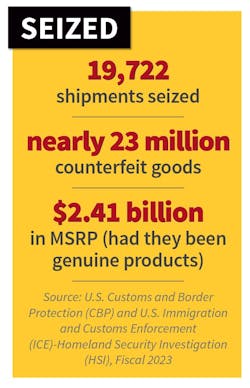Cybercriminals aren’t the only thieves with their eyes on manufacturers, only the most recent. Hypertherm Associates recently chalked up a big win in its global battle against patent infringers. In March, the Hanover, N.H.-based manufacturer of industrial cutting products reported that it had secured victory in a five-years-long battle against Chinese manufacturer Changzhou Termmei (TRM) for what Hypertherm said was an infringement on its Duramax Electrode and PowerPierce XD shield patents from 2017 to 2019.
Moreover, Hypertherm collected what it described as the “largest damages award” it had ever secured in China. While the company declined to provide an exact award figure, Brett Hansen, Hypertherm’s director of intellectual property, said “it was definitely painful” for the offending party.
“It’s our largest win in China to date,” he says.
That’s not Hypertherm’s only recent bout with IP infringers. Earlier in 2023, the manufacturer reported that raids in the United Arab Emirates of two connected counterfeiting operations had led to the seizure of hundreds of counterfeit Hypertherm consumables. In that event, the manufacturer teamed with a Dubai-based law firm and worked with the Dubai police to get the fakes off the market.
Intellectual property infringement is a big issue for Hypertherm, an employee-owned company with a workforce of about 2,000. Hansen says the company has multiple IP issues open around the world, and he estimates the manufacturer loses several million dollars in sales a year to counterfeits and patent-infringing products in the aftermarket.
The concern is big enough that the company has grown from having a single patent attorney to having a five-person intellectual property team. Moreover, the marketing and sales teams in Hypertherm’s Asia regional office in Shanghai have received IP training, “so they’re always looking for issues for us,” Hansen says. “It’s a companywide effort to make this happen.”
Illegal Activity Takes a Global Toll
It’s not just a Hypertherm or even a U.S. manufacturer concern, however. Within the past few months, the BMW Group and Amazon’s Counterfeit Crimes Unit announced they had won a joint civil lawsuit in Spain related to counterfeit parts. And in November, French sound systems manufacturer L-Acoustics held what it described as a “destruction event” in Tampa, Florida, to dispose of counterfeit speakers after winning a U.S. court judgment against a Florida rental company.
Counterfeits and IP infringement are a global issue, with implications for product safety and quality, consumer health and manufacturers’ bottom lines. So even as cybersecurity threats (which include elements of IP theft) gain manufacturers’ attention, don’t lose sight of the tried-and-true methods schemers are using to make money on your pain. And don’t overlook actions you can take to reduce their success rates.
Quite frankly, no one has a full accounting of the dollars lost to counterfeits and IP infringements, but what is unquestionable is that massive monies are lost. For example:
- Nearly 23 million counterfeit goods were seized in fiscal 2023 by U.S. Customs and Border Protection and U.S. Immigration and Customs Enforcement-Homeland Security Investigation. The value, had the goods been real, was more than $2.41 billion based on manufacturer’s suggested retail price, the enforcement agencies said.
- Counterfeiting subtracted nearly $320 billion from the U.S. economy in 2021, according to the National Association of Manufacturers.
- Globally, it seems impossible to know the complete economic toll. Estimates vary wildly, not surprising given the endeavor’s illegal nature. One statistic, presented by the National Crime Prevention Council, suggests that the global counterfeit goods economy is an estimated $2.3 trillion.
Toss other types of IP infringement into the mix, and the monetary toll only grows.
Tackling the IP Theft Challenge
That said, champions of IP protection do notch wins. The National Intellectual Property Rights Coordination Center initiated 623 cases related to IP theft and commercial fraud in FY 2023, for example. The center also reported 434 criminal arrests and 206 convictions. And that speaks only to U.S. activities. Similar pursuits occur around the globe.
Moreover, multiple ongoing efforts aim to make counterfeiting and other IP infringement a tougher livelihood to pursue. Manufacturers can be part of the solution. Here’s how.
Recognize Trouble Spots
When it comes to counterfeiting, one country always comes to mind. “It’s China, China and China,” says Hypertherm’s Hansen. “And the web makes it easier for China to throw up a website in Brazil or Colombia and advertise Hypertherm parts … and they’re counterfeit.”
The proof is in the data. China routinely leads, and often by a wide margin, as the leading source of counterfeit goods seized in the United States, according to U.S. Customs data. In fiscal 2023 China represented approximately 61% of the MSRP value of all intellectual property rights seizures.
For Hypertherm, having a team member based in China is important to its pursuit of patent infringers in that country. “For years I was doing this kind of by myself with a team member in the U.S. through an American Chinese law firm. It was successful, but it was slow and not nearly as efficient,” Hansen says.
Having a person in the country, who knows the language, understands the laws and court system, and who can assist in evidence collection, “that’s where we won this [TRM] case.”
“Having somebody who you can trust is in China is invaluable,” Hansen says.
China is not the only trouble spot for Hypertherm. While that country dominates regarding counterfeits, aftermarket products that infringe on the manufacturers’ patents are its bigger IP challenge currently, and Hansen cites other countries of origin: Czech Republic, Italy, occasionally the U.S. “and more Brazil and Mexico are showing up these days,” he adds.
The U.S. government also does its part to shine a light on questionable players. Earlier this year, the Office of the U.S. Trade Representative released its 2023 Review of Notorious Markets for Counterfeiting and Piracy, also known as the Notorious Markets List. The report, which has been published for more than two decades, highlights online and physical markets believed to facilitate or participate in trademark counterfeiting or copyright piracy.
The 2023 list identifies 39 online markets and 33 physical markets in 18 countries. It’s not an exhaustive list, nor does it constitute any sort of legal findings, but it does provide a lens by which to keep an eye out for counterfeiters.
In late April, USTR is expected to release the 2024 Special 301 Report, the agency’s annual review of countries with inadequate IP protection rights or inequitable market access to U.S. patent holders.
Consider Technology Solutions
Don’t overlook a technology assist. The global anti-counterfeiting packaging market size was valued at $149 billion in 2023, according to Precedence Research, and it is predicted to reach nearly $485 billion by 2033. Such packaging solutions include a host of options, from holograms and RFID tags to special seals and labeling.
Hansen says Hypertherm deploys a variety of technologies to deter counterfeiters and other IP infringers, including molding its trademark into its packaging and others that it prefers not to identify. “And we’re looking for next-generation technologies like digital fingerprinting and other things that will allow you to really stop [infringers] in their tracks,” he says.
3M has recently taken an app approach to counterfeits. The manufacturer in April announced the launch of its Verify app, which aims to help buyers be sure they have acquired authentic 3M disposable respirators by validating a carton of disposable respirators in real time using advanced technology.
“We established the 3M Verify app to help protect the health and safety of workers across industries. 3M aims to help ensure that customers are protected while working and that they do so with a properly manufactured 3M product that undergoes thorough quality and technical rigor,” the manufacturer said in a statement. 3M also makes it easy to report suspected counterfeit products on its website, a practice shared by Hypertherm and other manufacturers as well.
Movement on the Legislative Front
Recent legislation has taken aim at counterfeiting, primarily as it relates to online trading platforms. For example, the INFORM Consumers Act went into effect in late June 2023. More formally known as the Integrity, Notification and Fairness in Online Retail Marketplaces for Consumers Act, the new law aims to add transparency to the identity of certain third-party sellers of consumer products by requiring online marketplaces to collect certain information.
The scope of manufactured goods addressed by the law is limited by the definition of “consumer product,” which includes “tangible personal property for sale and that is normally used for personal, family, or household purposes,” according to the Federal Trade Commission.
Then there is the Stopping Harmful Offers on Platforms by Screening Against Fakes in E-Commerce Act, also known as the SHOP SAFE Act. Originally introduced in 2020, a modified version was introduced in the U.S. Senate in September 2023. Similar to the INFORM Consumers Act, the SHOP SAFE Act takes aim at removing counterfeit products from e-commerce platforms. Among other actions, the bill would establish trademark infringement liability for e-commerce platforms in certain circumstances if counterfeit products were sold.
The act has both champions, including the National Association of Manufacturers, and detractors, such as the Information Technology & Innovation Foundation, which has stated the act would “make online shopping more of a hassle” without increasing consumer protections.
It's too soon to say whether the SHOP SAFE Act will advance. However, wrote lawyer Marcella Ballard, a partner at Venable LLP, in an email comment, “The requirement for sellers to provide valid identification in order to sell on e-commerce platforms is not onerous and would go far in preventing repeat offenders and so–called whack-a-mole approaches to the enforcement by brand owners against the proliferation of harmful counterfeit products that are being rampantly sold anonymously online.”
Hypertherm’s Hansen has observed a change in IP infringement over time. “I would say that the depth of it has decreased in the past 10 years, but the breadth is increasing.” And “we’re catching some, but not enough.”
While the pool of players in any one country may have lessened, the nature of the global economy has increased the territory in which they operate. The lesson here: Don’t let cybercrime steal your attention from another illegal activity that remains in play.




